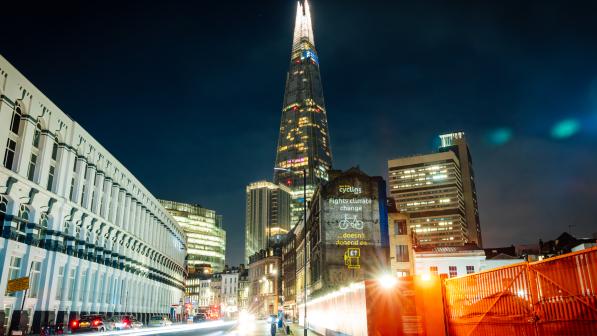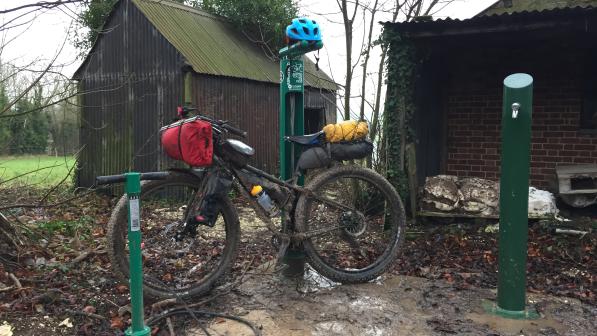Great rides: Following HG Wells’s 'The Wheels of Chance' cycle route

"You are, I perceive, cycling through this delightful country?" asked the clergyman.
"Touring," explained Mr Hoopdriver.
"I can imagine,” said the clergyman, “that, with a properly oiled machine, there can be no easier nor pleasanter way of seeing the country."
"No,” said Mr Hoopdriver, “it isn’t half a bad way of getting about."
It was at this point in HG Wells’s 1896 novel The Wheels of Chance that I decided to try to follow the route taken by Hoopdriver, the story’s protagonist. The book is fiction but the places and views described are real. Author HG Wells (The Time Machine, The War of the Worlds, The Island of Doctor Moreau, and so on) was a very active cyclist, roaming widely around the south of England where the novel is set. I wondered: could you ride the same route today? And if so, how would it compare?
So it was that I found myself on Putney High Street on a July morning, contemplating the rush hour traffic. I’d researched the route carefully using contemporary maps and the excellent cycle.travel website to waypoint the places named in the story. Some of the novel’s byways are now A-roads and 70mph dual carriageways, but in most cases there’s cycle infrastructure alongside. I would never be far from Hoopdriver’s route.

The riding forth of Mr Hoopdriver
Setting off from Putney I soon left the heavy traffic behind, and from Putney Heath a series of cycleways took me towards Kingston upon Thames. Along the way I stopped at several places that feature in the book, although the quiet lanes Hoopdriver wobbles his way along on his first morning are now the A3 and A308. Never mind: I was enjoying myself; the segregated paths were pleasingly adequate; and Kingston upon Thames was a nice stop for lunch. By this point Hoopdriver has fallen off at least once, has found the hills taxing and has managed to learn how to ride his heavy secondhand machine. In comparison, I was doing all right.
Between Kingston and Guildford, Wells packs in plenty of commentary on cycling, as well as Hoopdriver’s first encounter with the ‘Lady in Grey’, Jessie, whose proficiency on a bike far surpasses Hoopdriver’s. After a quick stop in Esher to visit the Marquis of Granby pub, which gets a mention in the book, I was on the lookout for “a charming little place between Cobham and Esher, where a bridge crosses a stream”.
This is where Hoopdriver meets the cad of the story, Bechamel, who is fixing a puncture on his own bicycle. The 1913 edition has an illustration of the encounter. Alas, I didn’t find anything like that illustration between Cobham and Esher. Before joining the six-lane A3 on what I expected would be a very sketchy cycle path (it was), I paused to check the map. It dawned on me that the bridge on which I was standing looked familiar... Success! The place did exist, just in a different location from the story. I rode on.
I ambled into Guildford later that afternoon and had another happy experience: capturing a recreation of an illustration of its pretty high street. Hoopdriver finds accommodation at a ‘coffee tavern' (confirming HG Wells as a visionary futurist in my opinion) for very little outlay. I settled instead for the Puttenham Barn bunkhouse outside town.

How Mr Hoopdriver reached Midhurst
The next day, after a visit to Guildford Castle, I headed south. From this point on, I would be overtaking the narrative. Hoopdriver’s “ten days or so” would be four for me, and between here and Bognor Regis lay some hills. Hoopdriver has to push his machine up the hill to Kingston earlier in the story, but at no other time are hills mentioned as challenging. I contemplated this as I rolled into Midhurst, nurturing aching legs from the steep climbs I’d traversed, and wondered if I’d overreached myself, given that the afternoon would take me over the South Downs.
Before that challenge, I had Midhurst to explore. Midhurst was where Wells went to school, then later lived and worked, first as a chemist’s apprentice and then as a teacher at his old school. A lot happens here in the Wheels of Chance. Hoopdriver stays in a room above a sweetshop next to the Angel Hotel (as did Wells in real life), and I was pleased to find that the sweetshop and hotel still exist. Unfortunately both were severely damaged in a fire a few months after I visited. But the town’s stocks are still there, as is the doorway in which Hoopdriver and Bechamel have a farcical confrontation.
Pushing on, I had a choice: the A286 or the South Downs Way? I took the scenic route… and paid for it with overgrown bridleways and an hour of hike-a-bike in the first heatwave of the year. The view was worth it, however, and the ride from the downs towards Chichester along the Centurion Way was fast and fun. I made a mistake here: instead of eating a hearty dinner after all that climbing, I pushed on to Bognor Regis, where I suffered from the dreaded bonk. At Bognor, Hoopdriver, realising Jessie’s plight, helps her escape from Bechamel. They head off into the night together, Hoopdriver having upgraded his bicycle by the simple expedient of stealing Bechamel’s. It must have been a good bike because they fairly whizz along for the rest of the story!

The pursuit
The next day I followed in their wheel tracks, heading west towards Fareham. This stretch, following NCN2 for a while was… functional. But Hoopdriver’s route from Fareham towards Winchester, through the lanes and rolling countryside of Hampshire, was very pleasant in early July. The narrative here involves a trio of pursuers, including Jessie’s mother, arriving by train and almost catching them at Botley. I followed on, passing through Winchester and on to Wallenstock.
Wallenstock? The place doesn’t exist! Wells had clearly given Stockbridge a fictional place name, for reasons unclear to me. Perhaps it had to do with him having Hoopdriver fall out with the locals and get in a fight? Nothing that exciting happened to me, fortunately.
Wells’s story takes a leap from chapters 32 to 33, with Hoopdriver and Jessie embarking on an elaborate doubling manoeuvre that puts them in Blandford Forum. There’s no mention of the journey but the route I took, through Salisbury and Cranborne Chase AONB, was pretty. The quiet roads allowed for some reflection on the differences in touring between Wells’s time and now. For example, Hoopdriver carries nothing more than “a neat packet of American cloth behind the saddle containing his change of raiment”. His cycling attire is a brown cycling jacket – “a Norfolk jacket thing” – and checkered stockings. There’s no mention of waterproofs or cooking sets or tents. The roads are all gravel. And cars? They practically didn’t exist! Clearly, bikepacking on gravel bikes was all the rage in 1896.
My last day took me from Dorset back into Hampshire, where the Wheels of Chance comes to an end. A chase across the New Forest involving an assortment of bicycle designs makes for some comic moments, culminating at the Rufus Stone where a reckoning takes place at a nearby hotel – now a Happy Eater service station that’s only accessible by car.
I enjoyed miles of glorious cycling along gravel tracks, and at the Rufus Stone itself, with nothing but the forest and a few ponies for company, I reflected on the journey. Despite the passage of time, the novel’s route remains and, for the most part, it winds through villages and forests, purple heathland, grassy downs and along quiet country lanes where one can ride at one’s ease. More than a century on from Wells’s novel, cycling remains "not half a bad way of getting about."
Cycle magazine
Every two months Cycling UK members receive Cycle magazine, filled with interesting and informative articles, news and reviews for all cyclists.
Members can read the magazine in full online; non-members can read selected highlights.

